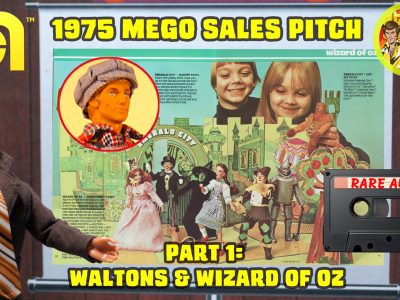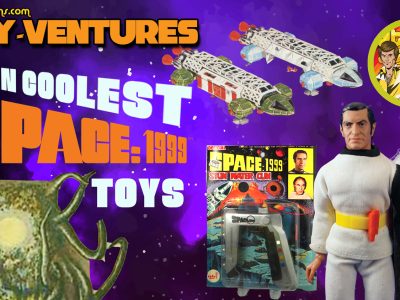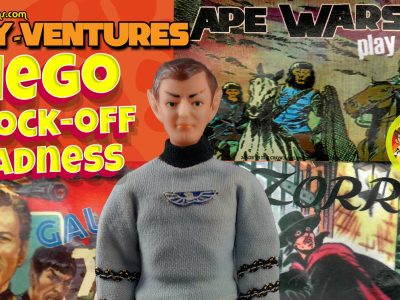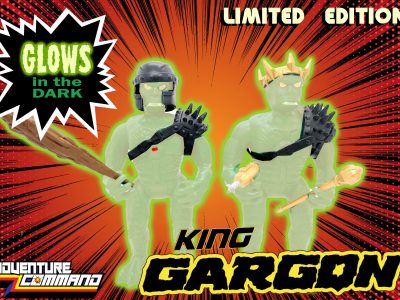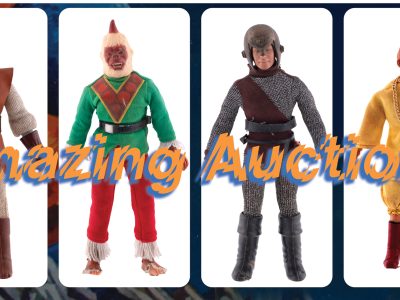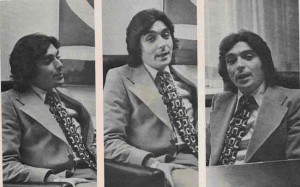 We here at the Mego Museum were excited to find this vintage toy industry publication interview with then Mego President Marty Abrams. This 1974 piece gets Abram’s opinions on the Toy Industry, Licensing and his vision of the future – specifically his then red hot Planet of the Apes license. Part two will follow next week, but for now enjoy!
We here at the Mego Museum were excited to find this vintage toy industry publication interview with then Mego President Marty Abrams. This 1974 piece gets Abram’s opinions on the Toy Industry, Licensing and his vision of the future – specifically his then red hot Planet of the Apes license. Part two will follow next week, but for now enjoy!
INTERVIEWER: Let’s start with a brief history of Mego, primarily in terms of how it came to be where it is right now.
ABRAMS: Mego, itself, has really gone through a metamorphosis over the last four years. Our attitude was quite simple. We had a non-proprietary product line that we felt in our particular area of expertise was a winding road to nowhere specifically because our main competitors were our own customers, not any other toy company.
They were going to the Far East and buying the product direct rather than going through an importer. The real demise of the import-oriented lines was due to the spiraling costs and the ability of the retailer to go direct himself. This really brought a quick and absolute end to the importer that the industry knew five years ago. We changed our operation very simply. We went from an import operation to a proprietary line through several very overt moves, specifically public offerings to place in the Spring of 1970.
The public offerings allowed us to build and buy factories that could supply us with the product that we required. We built up our selling organization and our marketing organization for a proprietary line. It gave us the banking facilities and financial strength to go in and create a T.V. product, a promotional product with a handle, with a hood, with a purpose that became a wanted product bv the American consumer.
Our philosophy has always been, by the way, not to build a product for one year and gone the next. We’re building, as we see it, a very broad-based line which will be with us for several years. As in other categories, they reach an apex and they may come down a little bit and run into the hill and valley graph line. We shy away from that individual item that doesn’t have an overall line concept. We will not get involved if it doesn’t fit into our being. The company has gone from the non-proprietary line of 1970 from $12 million in sales, to this year with $37-$39. million worth of sales. So in terms of our strength in the industry, that’s been enhanced as well. In order to make an effective change in a business, you can’t do it in a single year.
We never intended to do it in a single year. As far as the company is concerned, when we went into proprietary products, we did not phase out immediately all of our non-proprietary products. It was a three year program, and this year 1974, is a capsule of that program. We’ve totally wound out all the non-proprietary products and only that which stays, is that which was created by the company the last four years.
INTERVIEWER: What has been your background in the toy industry?
ABRAMS: Actually, I’ve been with the company for 11 years it is individually owned by our family. I came aboard when the company did $800,000 worth of business. So it’s really been a haul from virtual oblivion to a position that we consider today as one of major importance
INTERVIEWER: Can you outline more specifically some of these elements that you feel have led to such an enormous growth rate?
ABRAMS: One of the most treacherous things to do is to go from non-proprietary to proprietary goods, whether it be in the cosmetic business, housewares business or the toy business. When you make that total shift, if it’s not done with a complete plan and the plan laid out in stages, then you’re kidding yourself and you’re kidding your company because you can get into real financial problems. The major emphasis change has really been in organization, in thinking in terms of the overall organization. The basis for building our own facilities … we control what comes out of our own factories both in the United States, in Taiwan, and in Hong Kong. This is by no means an operation that is limited in scope. We have worldwide scope. But by not only building the operations aspect, but by building the financial stability by getting the proper banking facilities, by getting the proper marketing background and marketing facilities, by developing the right research and development people, by getting the right product mix, by developing enough sophistication in your computer analysis, by knowing where you’re heading.
As you can see as I’m talking, it was not done in an imaginary state where we developed a Polaroid Land Camera and from that we owned the patent and the world beat a path to our door. It was a total organizational pull. And trying, in our eyes, to find the best people within the company and apply their talents where they could be best used, or if need be, when you grow the way we have, to go outside our company and find the best people and to create within their own basis, their own head, the excitement that we were trying to put forth to build that foundation.
And essentially that’s what we’ve done. We’ve got, as far as we’re concerned, the best advertising agency, the best production company, ‘the best banking institutions, the best internal people. Now that may not very well be the case in terms of General Motors, but in terms of our company and our needs, they are. And that’s the way we treat them and that’s the way our organization moves. That type of motivation.
INTERVIEWER: What kind of philosophy is behind your apparent commitment to so many licensed Characters, licensed figures?
ABRAMS: Conceptually, our licensing attitudes are much different than anybody else. I find it quite abrasive to see a product that has no apparent connection to a licensed property, for a label to be put on it and to go out into the marketplace because that particular property at that particular time is a wanted property … taking a product and putting a label on it and it’s a baseball bat and it’s a figure with no relationship to a baseball bat. Hank Aaron, Willie Mays . . . putting that figure on it there’s a connection, but to put a Batman on a baseball bat, there’s no interconnecting meaning. [Editors Note: That didn’t stop a rival toy company from doing just that however]
Ultimately, if that property in terms of license property is a hot property, the distribution is going to be made because of the overwhelming support of the property. But in the long pull, and again we’re talking about our philosophy, we don’t go into a property for one year. We do not go in, to milk it and move out. Ours is a three, four, five year pull. And the success of our Super Heroes in terms of that, we’ve built the second year a much stronger category and the third year we’ll be even stronger. We’re into our properties for long pull, rather than to deplete it in one year or more. Our attitude has been to find the right properties. You get a vast reservoir of advertisement in the properties that we’re using, whether they be in comic books, whether they be in television, whether they be in paperback, whether they be in syndication T.V. or radio programming. There’s a vast reservoir of advertising that we feel is worth paying the licensing royalty; but we will not do it indiscriminately, by paying the royalty for putting something on the product that will not have an ultimately long pull down the road.
We have, for example, gone into licensing of Evel Knievel bicycles and bicycle accessories. The property itself creates excitement, creates flamboyance, understanding who and what Evel is. We’ve developed a program with Evel to make the American public much more aware of bicycle safety. As a matter of fact, in all of our packaging it states clearly what the Bicycling Association rules of safety are.
Evel on several of his interviews on television has told the American public, specifically kids, that bicycle safety for them is very important. He does his jumping and his performing as a professional under controlled conditions. The connection between Evel and safety is really not so strange when we reflect back to the whys, whats and the wherefores. His is done as a total controlled experiment. I was fortunate enough to be at Twin Falls and saw him go down into the canyon, and with all the publicity and all the action that took place there, even with the chute opening prematurely, there were such safe precautions made that he came out virtually unhurt.
That’s really what his attitude is. Children fantasize. We try to get into their heads in terms of their fantasies. It’s very tough as an adult to say what a seven or eight or nine year old is thinking. You really have to bring yourself down to heir level in the whats and wherefores. They’re going to fantasize anyway and they’re going to have their excitement anyway in terms of experimenting with living. It can be done under more controlled circumstances, such as motor crossing, which is a fad that is taking place on the west coast and is coming east now. It is heavy-duty bicycling done on dirt tracks where the kids race their bicycles, but they do it with protection, with helmets, on dirt tracks, with very strong reinforced frame bicycles. They’ve got to enjoy going out and growing up and living their fantasies until their
adult years. But they do it under controlled conditions. All of us as children when we were growing up, whether we had toys or not, experimented with different factors and that has to be done under reasonably controlled conditions. And that is how we feel, as well as how Evel feels.
And in terms of this area, bicycle equipment, in terms of Evel Knievel bicycling accessories, this is how we feel in terms of our licensing. These things are tied together, as are all of our products. And it’s an area that we look forward to in a long-term pull, rather than in a short thing where we come up with a bicycle horn or a bicycle radio or a flag where every manufacturer in the country has come out with a flag. What happens is categories become over-saturated. The first turndown in any specific product in the category your buyers say, “This category slowed down, or that category slowed down” because there’s no intrinsic value.” And once that happens, your licensing becomes of no value. And that’s why we look at our licensing very, very carefully. And we find that it’s much easier to sell our product because of the advertisements put behind the properties. We don’t have to go in and spend $3 million on a property to get the idea across because those dollars have already been spent by the T.V. stations, by the media on the property, and we turn around and just haul them in where our product and our licensing fit together like hand in glove. So the percentage of advertising comes way down in terms of our overall sales promotion. What that really means in terms of the consumer is that 1 don’t have to inflate my prices by 30, 40 and 50 in order to sell my product. With that happening and looking at my entire product category as compared to other people in this area, we’re 20-25 less. And the reason we’re 20-25 less is I don’t have that advertising budget to have to introduce new products.



